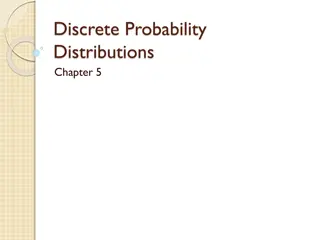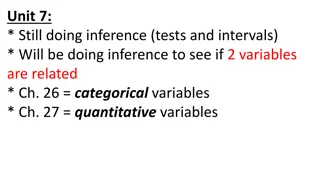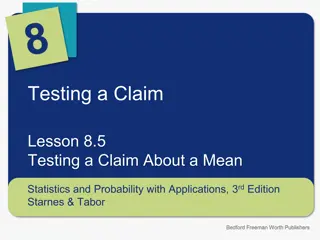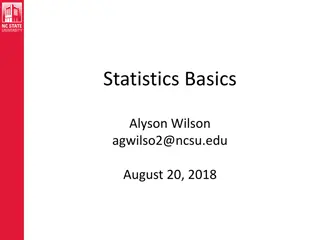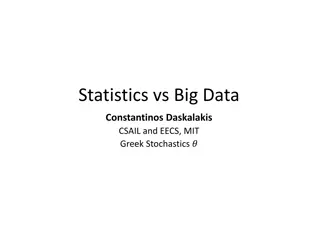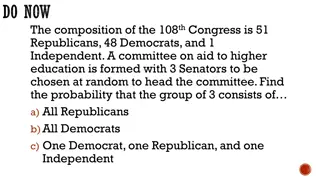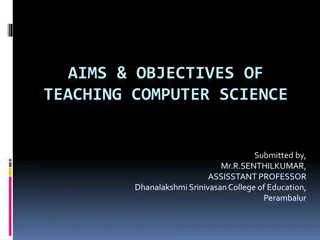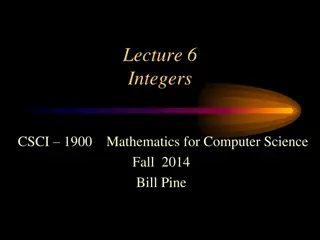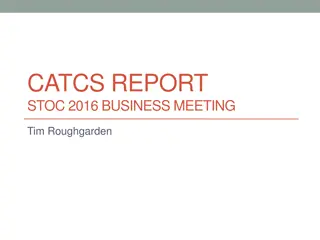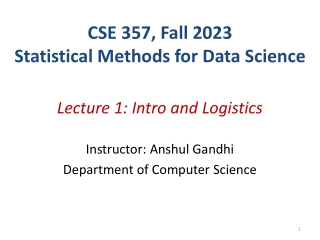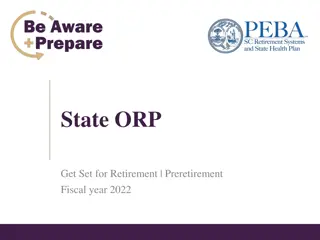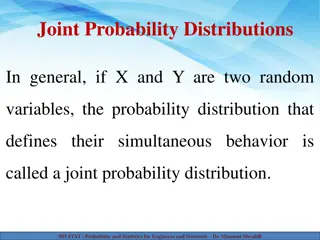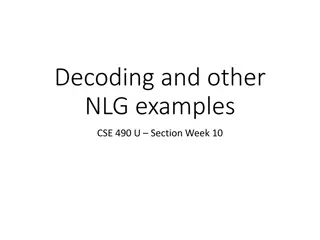Distributions of Computer Science in the 1990s
The study of distributions in Computer Science began in the 1990s with a focus on CPU load balancing and job migration. Concepts like preemptive migration and non-preemptive migration were explored to balance job allocations on machines. These studies laid the foundation for understanding the distribution of file sizes, IP flow durations, and job CPU usage in computing applications.
Download Presentation

Please find below an Image/Link to download the presentation.
The content on the website is provided AS IS for your information and personal use only. It may not be sold, licensed, or shared on other websites without obtaining consent from the author. Download presentation by click this link. If you encounter any issues during the download, it is possible that the publisher has removed the file from their server.
E N D
Presentation Transcript
Chapter 10 Heavy Tails: the distributions of computing "Introduction to Probability for Computing", Harchol-Balter '24 1
Distributions weve seen so far We ve studied several continuous distributions so far: Normal( , ?2) Uniform(a, b) Exp(?) Q: Which of these represents CS distributions? distribution of file sizes distribution of IP flow durations distribution of job CPU usage 2 "Introduction to Probability for Computing", Harchol-Balter '24
Distributions weve seen so far We ve studied several continuous distributions so far: Normal( , ?2) Uniform(a, b) Exp(?) Q: Which of these represents CS distributions? distribution of file sizes distribution of IP flow durations distribution of job CPU usage None! 3 "Introduction to Probability for Computing", Harchol-Balter '24
Distributions of CS were studied in 1990s It all started with a computer science question [Harchol-Balter & Downey, Exploiting Process Lifetimes for CPU Load Balancing, SIGMETRICS 1996] CPU load balancing: Migrate jobs from heavily-loaded to lightly-loaded machines Q: In CPU load balancing, which kind of job migration makes sense? P: Preemptive migration Preempt/migrate jobs after they ve started running. Active process migration. NP: Non-preemptive only Don t preempt job once it starts running. Only load balance newborns. VS. 4 "Introduction to Probability for Computing", Harchol-Balter '24
Distributions of CS were studied in 1990s It all started with a computer science question [Harchol-Balter & Downey, Exploiting Process Lifetimes for CPU Load Balancing, SIGMETRICS 1996] CPU load balancing: Migrate jobs from heavily-loaded to lightly-loaded machines Q: In CPU load balancing, which kind of job migration makes sense? Why is NP preferred? P: Preemptive migration Preempt/migrate jobs after they ve started running. Active process migration. NP: Non-preemptive only Don t preempt job once it starts running. Only load balance newborns. VS. 5 "Introduction to Probability for Computing", Harchol-Balter '24
Distributions of CS were studied in 1990s It all started with a computer science question [Harchol-Balter & Downey, Exploiting Process Lifetimes for CPU Load Balancing, SIGMETRICS 1996] CPU load balancing: Migrate jobs from heavily-loaded to lightly-loaded machines Q: In CPU load balancing, which kind of job migration makes sense? P: Preemptive migration Preempt/migrate jobs after they ve started running. Active process migration. NP: Non-preemptive only Don t preempt job once it starts running. Only load balance newborns. NP is cheap! VS. P is costly! 6 "Introduction to Probability for Computing", Harchol-Balter '24
CPU load balancing: Migrate jobs from heavily-loaded to lightly-loaded machines To better understand how to think about this question, let s introduce some vocabulary 7 "Introduction to Probability for Computing", Harchol-Balter '24
Some vocabulary A job s size is its total CPU requirement (a.k.a. CPU lifetime) job A job s age is its total CPU usage so far A job s remaining size is its remaining CPU needs remaining size size age 8 "Introduction to Probability for Computing", Harchol-Balter '24
Some vocabulary A job s size is its total CPU requirement (a.k.a. CPU lifetime) job A job s age is its total CPU usage so far A job s remaining size is its remaining CPU needs remaining size size Q: Which of these do we know? age Q: Which of these do we NOT know? Q: Which of these is relevant to migration? 9 "Introduction to Probability for Computing", Harchol-Balter '24
Some vocabulary A job s size is its total CPU requirement (a.k.a. CPU lifetime) job A job s age is its total CPU usage so far A job s remaining size is its remaining CPU needs remaining size size We only know a job s age But what we need is its remaining size. o If remaining size is high, then pays to migrate, even if migration is costly. o If remaining size is low, then doesn t pay to migrate. age 10 "Introduction to Probability for Computing", Harchol-Balter '24
What does age tell us about remaining size? Q: Which of these jobs likely has higher remaining size? job A job B ? ???? > ? + ? ???? > ?} Q: Does this increase with ?? or decrease with ?? age 30s age 10s Q: What would the answer be if ???? ??? ? 11 "Introduction to Probability for Computing", Harchol-Balter '24
Failure rate: informally ? ???? > ? + ? ???? > ?} Increases with ? Decreases with ? Increasing Failure Rate I.F.R. Decreasing Failure Rate D.F.R. The longer you ve lived, the sooner you ll die The longer you ve lived, the longer you ll live Q: Examples? Q: Examples? 12 "Introduction to Probability for Computing", Harchol-Balter '24
Failure rate: informally ? ???? > ? + ? ???? > ?} Increases with ? Decreases with ? Increasing Failure Rate I.F.R. Decreasing Failure Rate D.F.R. The longer you ve lived, the sooner you ll die The longer you ve lived, the longer you ll live Lifetime of a car. Lifetime of a washing machine. Time you ve been friends with someone. Time you ve lived in your home. 13 "Introduction to Probability for Computing", Harchol-Balter '24
Failure rate: definition Definition: For continuous r.v. ?, with p.d.f. ??? and tail ??? = ?{? > ?}, the failure rate function for ? is: ??(?) =??(?) ??? Looks like a conditional pdf, where we re conditioning on ? > ? =?{? ?,? + ?? } ?{? > ?} ? ? ? ,? + ?? ? > ?} =??? ?? ??? So ??? is the instantaneous death rate! = ??(?)?? 14 "Introduction to Probability for Computing", Harchol-Balter '24
Failure rate: definition So ??? is the instantaneous failure rate! ? ? ? ,? + ?? ? > ?} = ??(?) Increases with ? ??? decreases with? ??? increases with? Decreasing Failure Rate D.F.R. D.F.R. Increasing Failure Rate I.F.R. Decreasing Failure Rate Lifetime of a car. Lifetime of a washing machine. Lifetime of friendship. Time lived in home. Q: Is there a distribution with constant failure rate? 15 "Introduction to Probability for Computing", Harchol-Balter '24
How does failure rate of job size affect P vs NP? CPU load balancing: Migrate jobs from heavily-loaded to lightly-loaded machines Q: In CPU load balancing, which kind of job migration makes sense? P: Preemptive migration Preempt/migrate jobs after they ve started running. Active process migration. NP: Non-preemptive only Don t preempt job once it starts running. Only load balance newborns. VS. If Job Size (CPU reqt.) has IFR or CFR If Job Size (CPU reqt.) has DFR 16 "Introduction to Probability for Computing", Harchol-Balter '24
So what is the distribution of job size? Results of measurements of millions of jobs [Sigmetrics 1996] Q: What distribution is this? Looks like Exponential, but NOT! 17 "Introduction to Probability for Computing", Harchol-Balter '24
Lets replot on a log-log scale ? ???? > ? =1 ? (? 1) 18 "Introduction to Probability for Computing", Harchol-Balter '24
Properties of the job size distribution ? ???? > ? =1 where ? 1 ? Q: is this a valid distribution? ??(?) = ? 1 ??? = 1 ? 1 ??(?) = ? 2 ? 2?? = 1 ??? ?? = 1 1 19 "Introduction to Probability for Computing", Harchol-Balter '24
Properties of the job size distribution ? ???? > ? =1 where ? 1 ? Q: What is the mean of this distribution? ??(?) = ? 2 ? ? = ? ??? ?? 1 ? ? 2?? = 1 All moments are infinite! ? 1?? = = 1 20 "Introduction to Probability for Computing", Harchol-Balter '24
Properties of the job size distribution ? ???? > ? =1 ? 1 where ? Q: What is the failure rate? ??(?) = ? 2 ??(?) = ? 1 ??(?) =??(?) ??? =1 ? D.F.R. 21 "Introduction to Probability for Computing", Harchol-Balter '24
Properties of the job size distribution ? ???? > ? =1 ? 1 where ? Q: Doubling property? 1 =1 2? 1 ? ? ? > 2? ? > ?} = 2 Job of age ? will make it to age 2? with probability half. 22 "Introduction to Probability for Computing", Harchol-Balter '24
Pareto Distribution Definition: ? ?????? ? , if Pareto was an economist in 1900. ?? ? = ? ?, ? 1 where 0 < ? < 2. Q: What is the distiribution of UNIX job sizes from 1996? A: ?????? ? = 1 23 "Introduction to Probability for Computing", Harchol-Balter '24
Pareto Distribution Definition: ? ?????? ? , if Pareto was an economist in 1900. ?? ? = ? ?, ? 1 where 0 < ? < 2. Properties of Pareto ? distribution: 1) DFR 2) Infinite variance -- Note: ?[?] is finite if ? > 1,but infinite if ? 1. -- All higher moments of ? are infinite. 3) Heavy-tailed property: The top 1% of jobs comprise 50% of the load -- For lower ? we have a heavier tail. -- Higher ? results in less heavy tail. Q: Where do heavy tails come up in economics? 24 "Introduction to Probability for Computing", Harchol-Balter '24
Bounded-Pareto Distribution Empirical distributions are always bounded. The Bounded-Pareto distribution has a Pareto shape but is finite. lower limit upper limit Definition: ? ????????????? ?,?,? , ?? ? = ? ?? ? 1 , ? ? ? where 0 < ? < 2 and where ? is a normalizing constant. BoundedPareto has similar properties to Pareto: -- (mostly) DFR -- near-infinite variance -- heavy-tailed property, assuming upper limit, ?, is large. 25 "Introduction to Probability for Computing", Harchol-Balter '24
What does all this mean for CPU load balancing? Properties of Pareto ? distribution: 1) DFR 2) Infinite variance 3) Heavy-tailed property: The top 1% of jobs comprise 50% of the load DFR implies: Older jobs have higher remaining sizes Pays to migrate older jobs Heavy-tailed property implies: Can get significant load balancing benefit from only migrating 1% of jobs 26 "Introduction to Probability for Computing", Harchol-Balter '24
What does all this mean for CPU load balancing? [Harchol-Balter, Downey Exploiting process lifetime distributions for CPU load balancing. SIGMETRICS 1996 Best Paper. Measured CPU lifetimes of UNIX jobs: BoundedPareto(? = 1) job size distribution Very high squared coefficient of variation: ?2 50. Showed P-migration pays and is superior to NP-migration Achieved CPU load balancing by only migrating the 4% oldest jobs. 27 "Introduction to Probability for Computing", Harchol-Balter '24
What do jobs look like today? 2020 study of jobs at Google run in Google Borg scheduler: [Tirmazi et al., Borg: The Next Generation, USENIX 2020.] # CPUs CPU-hours time # MB MB-hours 28 "Introduction to Probability for Computing", Harchol-Balter '24
Compute usage today 2020 study of jobs at Google run in Google Borg scheduler: CPU-hours used by jobs span 9 orders of magnitude Straight line on log-log scale fits Pareto(? = 0.7) distribution ?2= 23,000 Top 1% of jobs make up 99% of total CPU usage ?{CPU hours > ?} * For privacy reasons, all numbers shown are normalized by unknown constant. ? 29 "Introduction to Probability for Computing", Harchol-Balter '24
Memory usage today 2020 study of jobs at Google run in Google Borg scheduler: MB-hours used by jobs span 10 orders of magnitude Straight line on log-log scale fits Pareto(? = 0.7) distribution ?2= 43,000 Top 1% of jobs make up >99% of total CPU usage ?{MB hours > ?} * For privacy reasons, all numbers shown are normalized by unknown constant. ? 30 "Introduction to Probability for Computing", Harchol-Balter '24
Pareto distributions are everywhere! Job compute usage Job memory usage Web file sizes IP flow durations Wireless session times Phone call durations National wealth Damage due to earthquakes Damage due to forest fires The question is WHY? 31 "Introduction to Probability for Computing", Harchol-Balter '24


